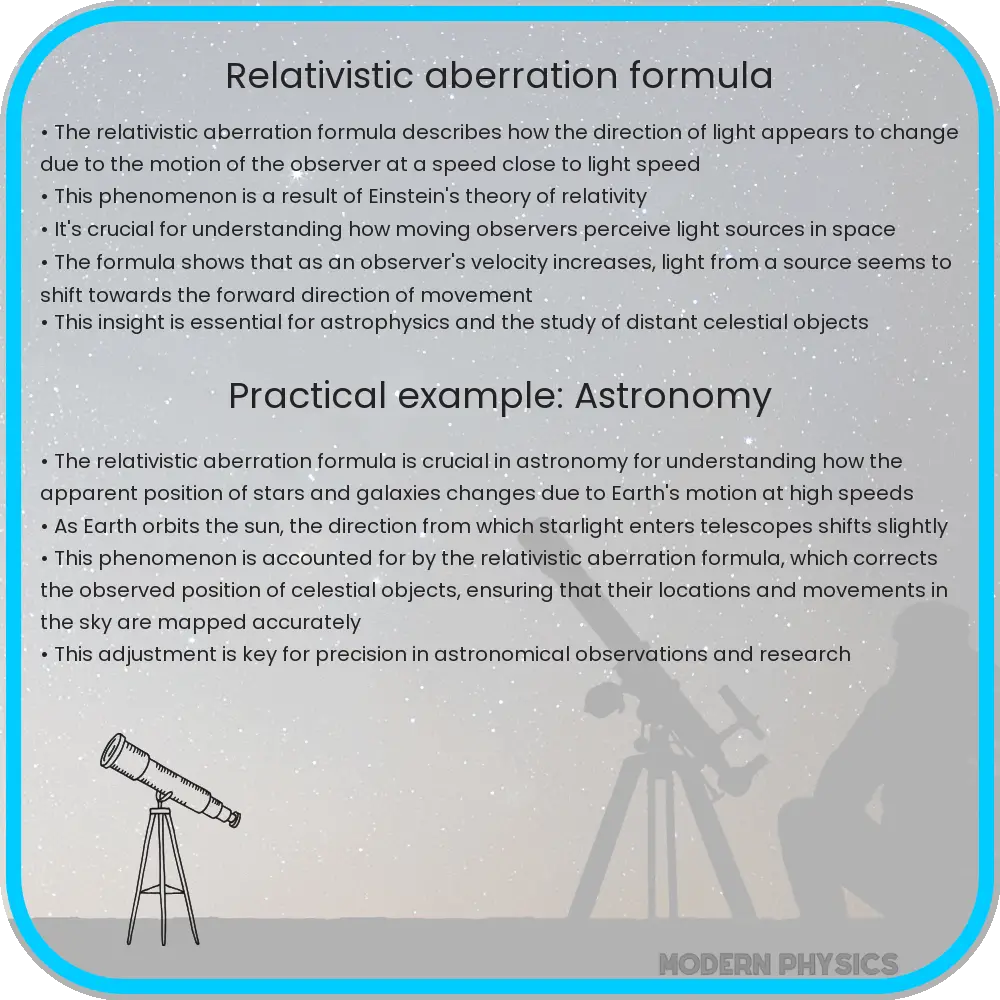Explore the intriguing concept of relativistic aberration, its formula, effects on light and velocity, and applications in astronomy and GPS.

Understanding Relativistic Aberration in the Context of Light and Velocity
Relativistic aberration is a fundamental concept in the field of astrophysics and physics, particularly when discussing the behavior of light in the context of high velocities. This phenomenon refers to the change in the angle of incoming light as observed in a moving reference frame, especially when such movement approaches the speed of light. The importance of understanding relativistic aberration lies in its application to astronomical observations and in the study of high-speed particles.
The Basics of Relativistic Aberration
At the heart of relativistic aberration is the principle that the speed of light in a vacuum is constant and does not change, regardless of the observer’s motion. This principle, central to Einstein’s theory of special relativity, leads to fascinating consequences when considering an observer moving at a significant fraction of the speed of light. As the observer’s speed increases, the apparent position of light sources shifts due to the need to reconcile the constant speed of light with the observer’s motion.
The Relativistic Aberration Formula
The relativistic aberration formula is mathematically expressed as follows:
- θ’ = arccos ((cos θ – v/c) / (1 – (v/c) cos θ))
Where:
- θ’ represents the observed angle of the incoming light in the moving frame.
- θ is the angle of incoming light in the stationary frame.
- v denotes the velocity of the observer relative to the light source.
- c is the speed of light in a vacuum.
This formula allows for the calculation of the apparent displacement of a light source due to the motion of the observer. It’s important to note that this displacement is a visual effect; the actual position of the light source remains unchanged.
Visualizing the Effect of Relativistic Aberration
To visualize the effect of relativistic aberration, consider an observer moving towards a distant star. In a stationary frame, the star may appear directly overhead (at a 90° angle). However, for an observer moving rapidly towards the star, the star appears to shift forward in the direction of travel, reducing the observed angle. This shift increases with the observer’s velocity, reaching a maximum when the velocity approaches the speed of light.
Applications and Implications of Relativistic Aberration
The implications of relativistic aberration are vast and significant in various fields of physics and astronomy. One notable application is in the realm of astrophysics, where it helps in accurately determining the positions and movements of celestial bodies. Astronomers must account for this effect when observing stars and galaxies from a rapidly moving Earth. Similarly, relativistic aberration plays a crucial role in the analysis of satellite communications and the Global Positioning System (GPS), as the satellites are moving at high velocities relative to the Earth’s surface.
Challenges and Considerations in Observational Astronomy
In observational astronomy, relativistic aberration poses unique challenges. Telescopes, both ground-based and space-borne, must be calibrated to account for the Earth’s motion to ensure accurate observations. Moreover, this phenomenon becomes particularly relevant when observing objects moving at relativistic speeds, such as jets from active galactic nuclei or particles in high-energy physics experiments. Failure to account for relativistic aberration in these scenarios can lead to significant errors in data interpretation.
Relativistic Aberration in Everyday Life
While relativistic aberration is predominantly a concern in high-velocity scenarios, its principles also find relevance in everyday technologies. For instance, the functioning of GPS systems, which are integral to modern navigation, relies on the precise understanding of this phenomenon. GPS satellites orbiting the Earth at high speeds and transmitting signals to receivers on the ground must factor in relativistic effects for accurate positioning.
Conclusion
Relativistic aberration is a fascinating and crucial concept in the realm of physics, shedding light on how motion at high velocities alters our perception of light. This phenomenon is not just a theoretical curiosity but a practical consideration in modern astronomy, satellite communications, and navigation systems. Understanding and accounting for relativistic aberration enable us to make precise observations and calculations, essential for navigating our world and exploring the universe. As we continue to venture into the cosmos and develop technologies operating at high speeds, the principles of relativistic aberration will remain an indispensable part of our scientific toolkit.
